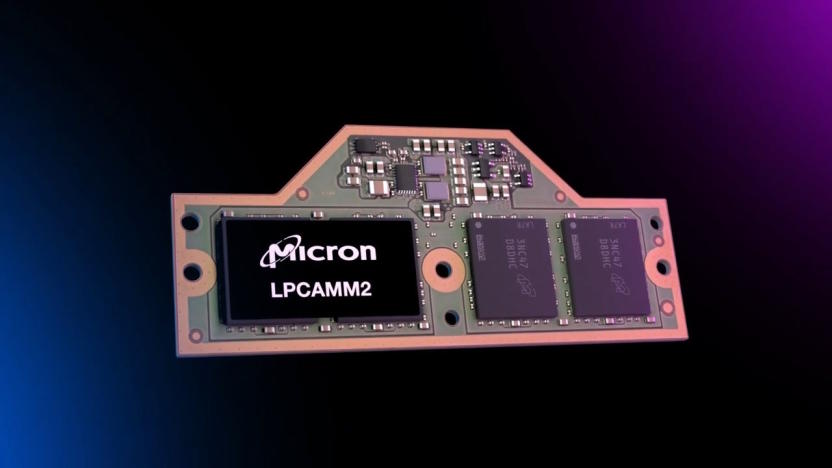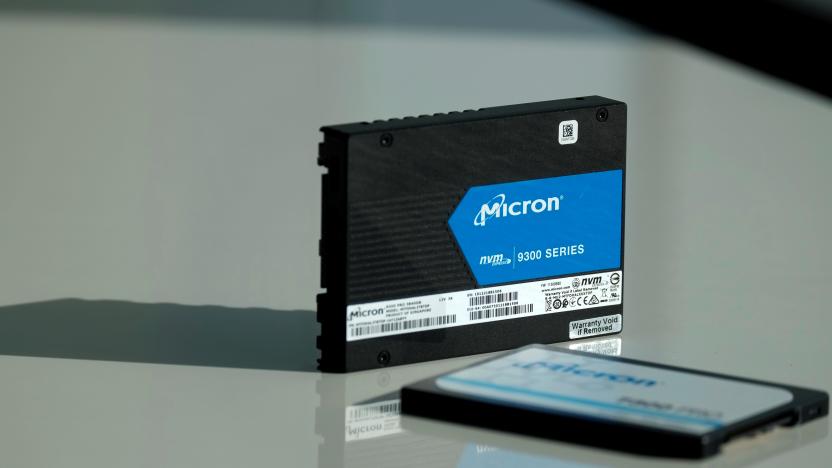Micron
Latest

Micron debuts LPCAMM2, laptop RAM that could finally replace SODIMM
Micron says it's the first to market with a compelling to standard laptop RAM: LPCAMM2 RAM using LPDDR5X modules.

Beijing bans Chinese companies from using Micron chips in critical infrastructure
China’s cybersecurity regulator has banned Chinese firms from buying chips from US memory manufacturer Micron.

The era of 1TB microSD cards has begun
While processors can no longer keep up with Moore's law, memory manufacturers keep cramming more storage into ever-smaller spaces. Micron and Western Digital have both unveiled 1TB microSD memory cards that will let you significantly ramp up your smartphone storage, for a price. The products are arriving not long after Lexar started selling the first-ever 1TB SDXC memory cards.

US charges Chinese, Taiwan firms for stealing secrets from Micron
Attorney General Jeff Sessions announced that the Department of Justice has filed charges against a Taiwanese company, a Chinese PRC-backed company, and three Taiwanese nationals of economic espionage against Idaho-based semiconductor manufacturer Micron over the production of F32nm DRAM. Sessions also announced the creation of the China Initiative, led by Assistant Attorney General John Demers, to identify Chinese trade theft and allocate the necessary resources to go after these cases.

SanDisk is reportedly eager to sell itself off
SanDisk is a mainstay of the storage world thanks to its memory cards and solid-state drives, but you might not see its name for much longer: Bloomberg sources hear that SanDisk is exploring the possibility of selling itself off. The company is reportedly talking to both Micron and Western Digital about a potential deal, although there's no guarantee that anything will happen. You shouldn't expect an acquisition in the immediate future, at any rate. SanDisk runs memory factories alongside Toshiba, and it'd likely have to get approval before changing that partnership.

Intel's 3D memory is 1,000 times faster than modern storage
Intel and Micron unveiled a novel new kind of non-volatile data storage device during a press conference on Tuesday. The chips, dubbed "3D XPoint" (pronounced "cross-point"), are being touted as the first new class of "mainstream memory" to hit the market since 1989. These new chips could soon speed up everything from cell phones and SSD laptops to genomic sequencers and supercomputers.

You'll soon get 10TB SSDs thanks to new memory tech
SSDs and other flash memory devices will soon get cheaper and larger thanks to big announcements from Toshiba and Intel. Both companies revealed new "3D NAND" memory chips that are stacked in layers to pack in more data, unlike single-plane chips currently used. Toshiba said that it's created the world's first 48-layer NAND, yielding a 16GB chip with boosted speeds and reliability. The Japanese company invented flash memory in the first place and has the smallest NAND cells in the world at 15nm. Toshiba is now giving manufacturers engineering samples, but products using the new chips won't arrive for another year or so.

Crucial M500 SSD review round-up: 960GB at $600 is cheapest in class, available now
Crucial's budget-friendly yet high-capacity 2.5-inch M500 SSD has finally cropped up for sale today, as have the reviews of it from the usual enthusiast sites. While it's still not exactly low-cost, many applaud the fact that the company's $600 960GB drive is the cheapest near-1TB model you can get on the market. It uses Micron's 20nm MLC NAND flash, a SATA 6 Gb/s controller and is the first to implement the new 128Gb MLC NAND die. According to Benchmark Reviews, it certainly bests its m4 predecessor with peak speeds that reach 500 MB/s read and 400 MB/s write, with 80,000 IOPS in operational performance. Both TweakTown and Anandtech concur that it's not quite as fast as its closest competitor, the Samsung 840 Pro, but as Anand Lai Shimpi said in his review: "If you need the capacity and plan on using all of it [960GB], the M500 is really the only game in town." TechnologyX, however, gives the nod to the 480GB model, if only because it's about $200 cheaper if you're willing to compromise on space. Crucial also offers the M500 in 120GB and 240GB for $130 and $220 for those with smaller wallets. If you're keen to see the full breakdown on this tiny wonder, head on over to the sources to judge for yourself, or just click on the Crucial link below to get your own.

Hybrid Memory Cube receives its finished spec, promises up to 320GB per second
The Hybrid Memory Cube Consortium has been almost too patient in developing a standard for for its eponymous technology -- efforts began 17 months ago -- but it at last has more than good intentions to show for its work. Its just-published HMC Specification 1.0 lets companies build platforms and RAM with 2GB, 4GB and 8GB chips incorporating the stacked, power-efficient technology, all without compatibility jitters from other supporters. The completed spec is a scorcher when living up to its full potential, too. With eight links, a memory cube can reach a peak 320GB/s (yes, that's gigabytes) of aggregate bandwidth -- more than a hair faster than the 11GB/s we often get from existing DDR3 memory. The Consortium is teasing us with more. Although we'll have to wait until the second half of the year before HMC 1.0 products appear in earnest, the Consortium already has a next-gen blueprint due in early 2014 that should nearly double individual data link speeds (from 15Gbps to 28Gbps). While we'd like to see the group walk the walk with real products before it talks more talk, there's still a chance that some memory performance bottlenecks could vanish for a good, long while.

Micron's RealSSD P320h PCI Express SSD gets reviewed: wildly fast, but a little unstable
"Taking one's sweet time" just took on an entirely new meaning. Well over a year after Micron first introduced its RealSSD P320h PCI Express SSD, the aforesaid device is finally hitting the general availability stage. And with that, the flood of reviews begins. What sets this guy apart right out of the box is its native stature; much like Fusion-io (and very unlike most all other rivals from OCZ, Intel, LSI, etc.), this thing sidesteps the mishmash of SATA / SAS controllers and opts for a direct-attached PCIe approach. At around $7,000, it's clearly aimed first at enterprise, but given Micron's history in the consumer space, one could assume that this kind of wizardry will eventually trickle down. The fine folks over at HotHardware found their tester to be shockingly quick, easily outpacing its rivals when it came to read and write performance. Unfortunately, the Windows drivers provided weren't exactly mature, which led to a few booting issues when swapping in varying motherboards. Of course, no one ever said the Ferrari of PCIe SSDs would purr without a bit of finagling. Hit up the links below for the full spiel.

Micron first to market with phase-change memory modules for portable devices (video)
Look out silicon and magnetic storage, here comes glass. Micron has announced production of the first commercial cellphone phase-change memory (PCM) modules, a type of flash RAM that works by changing a crystal solid to an amorphous state. The 1Gb chips will share a circuit board with 512Mb of standard volatile memory, just enough to go in feature phones for now -- but the company claims it will eventually offer larger modules for smartphone and tablet storage as well. PCM could scale to much faster speeds than conventional NAND flash, since it doesn't require a time-sapping erase before rewriting -- and with read speeds of 400MB/s, it's already into regular flash territory while still just a first generation product. Once the tech gets even quicker, PCM could even replace volatile RAM, allowing more secure storage in case of a power loss and reducing device costs and power usage. That means the glassy new kid could eventually bump silicon-based storage altogether -- ending its 40-year plus reign as king of the memory substrates. To see some of the ways it trumps NAND, check the video after the break.

Micron scoops up Elpida Memory, 50-percent production boost for $2.5 billion
There's no question that Micron has shifted its focus away from PCs in favor of producing components, shipping everything from SSDs to CMOS sensors in recent years, but the semiconductor manufacturer just took a $2.5 billion step even closer to bridging its gap between other companies in the same market, including Samsung, the chip producer's top competitor. Under the deal, Elpida Memory, which is headquartered in Tokyo, will fall within the Idaho-based conglomerate's growing umbrella, netting Micron a 50-percent boost in production capability. That increase did come at great expense, however -- the transaction included $750 million in cash and $1.75 billion in future installments (1,750 easy payments of one million dollars?), which are set to continue through 2019. The acquisition was also paired with a 24-percent stake in Rexchip Electronics for an additional $334 million, which will complement Elpida's investment, yielding a total 89-percent stake for Micron. While the amount does seem quite significant, investors appear to be on board, with Micron's stock ($MU) currently up more than 4 percent since this morning. Both deals will reportedly close within the next year.

Phase change memory breakthrough could lead to gigahertz-plus data transfers, make SSDs seem pokey
Often considered the eventual successor to flash, phase change memory has had a tough time getting to the point where it would truly take over; when it takes longer to write data than conventional RAM, there's clearly a roadblock. The University of Cambridge has the potential cure through a constant-power trick that primes the needed hybrid of germanium, antimony and tellurium so that it crystalizes much faster, committing data to memory at an equally speedy rate. Sending a steady, weak electric field through the substance lets a write operation go through in just 500 picoseconds; that's 10 times faster than an earlier development without the antimony or continuous power. Researchers think it could lead to permanent storage that runs at refresh rates of a gigahertz or more. In other words, the kinds of responsiveness that would make solid-state drives break out in a sweat. Any practical use is still some distance off, although avid phase change memory producers like Micron are no doubt champing at the bit for any upgrade they can get.

Micron teases working DDR4 RAM module, aims for late 2012 production
JEDEC is still finalizing the standards for DDR4, but that doesn't mean component manufacturers are holding back on developing the tech now. Samsung announced the first DDR4 DRAM module last year, and now Micron has announced that it's developed a working part of its own. Using its 30-nanometer technology, the 4GB x8 part is just the first of many products in the company's DDR4 portfolio -- it will expand to include x16 and x32 parts with initial speeds of 2400 MT/s and eventually the JEDEC's targeted of 3200 MT/s. So when will DDR3 seem like a distant relic? Well, Micron is already sending around samples to clients, and it hopes to begin full-scale production by the end of the year. As always, jump past the break for the full press release.

PoP Video peripheral turns iPod touches and iPhones into pico projectors for $99
While it may not be the first time we've come across such a concept, this PoP Video add-on is certainly quite different than, say, WooWee's Cinemin Swivel -- and significantly cheaper, too. The PoP Video pairs up with iPod touches (3rd / 4th generation) and iPhones (4 / 4S) via Apple's proprietary 30-pin connector, essentially turning your device into an unorthodox pico projector. According to PoP's site, the 3.5 ounce peripheral's capable of 960 x 540 video output and can give you up to two hours of "playtime" on a single charge -- achieved by way of micro-USB. It all wouldn't be worth it without the free iOS app, though, which lets folks tinker with settings and do what it's intended to do: project videos, pics as well as browsing within Safari. The $99 PoP Video is up for pre-order now, and you can get a quick glimpse of the accessory in action just past the break.

Micron ships RealSSD C400 mSATA SSD into slender Ultrabooks
The only problem with mobile gizmos getting even more mobile? The cost of those bantam components squeezed within 'em. That said, at least we have the option to trim a few more millimeters from the chassis of our next-generation laptops, as Micron has announced a new mSATA solid state drive that's engineered specifically for the increasingly crowded Ultrabook market. The RealSSD C400 emanates realness, boasting a form factor that's around the size of a business card and arriving with capacities ranging from 32GB to 256GB with a SATA 6Gbps interface. Furthermore, Micron has tapped its 25 nanometer process technology to craft these things, with OEMs having access to the first lot; upgraders can look forward to a Crucial-branded version later this year, but who knows how much you'll have to pay.Update: Looks like our pals at Storage Review have a full review up, replete with more benchmarks and charts than you could shake a 3- x 5cm stick at.

SanDisk makes 128-gigabit flash chip, crams three bits per cell, takes afternoon off
SanDisk has developed a chip that earns it membership in the exclusive 128-gigabit club. Not content with simply matching the Micron / Intel effort, SanDisk and its partner Toshiba claim their new memory uses 19- rather than 20-nanometer cells in the production process. Shrinking the size is one thing, but SanDisk's new chips also use its X3 / three-bit technology. Most memory stores just two bits per cell; cramming in another means fewer cells, less silicon, more savings, cheaper memory, happier geeks. Analyst Jim Handy estimates that the price per gigabyte for the tri-bit breed of flash could be as low as 28 cents, compared to 35 for the Micron / Intel equivalent. Full details in the not-so-compact press release after the break.

Micron appoints Mark Durcan as new CEO
In the wake of last week's fatal plane crash that took the life of its CEO, Micron Technology has appointed a successor, Mark Durcan. The former CTO has been with the company since 1984, and has -- per company bylaws -- been serving as interim chief since February 3rd. Robert Switz, the company's previous Board Director, will assume the duties of Board Chairman and Mark Adams, formerly the VP of Worldwide Sales, has been named as the company's President. In a press release announcing the appointments, the new CEO wrote that the company was "deeply saddened" to learn of the death of its top executive, and that the management team would work relentlessly to "continue to move the company forward."

Steve Appleton, CEO of Micron, dies in plane crash at 51
Sad news to report this Friday. Steve Appleton, the CEO and Chairman of Micron, died this morning in an airplane crash shortly after takeoff from the Boise, Idaho airport. He was the only one aboard, and was piloting a fixed wing, single engine kit aircraft. Appleton started working at Micron in 1983 shortly after graduating from Boise State University, first working the production line and eventually rising through the ranks to become the company's COO in 1991. He took the reins of Micron in 1994. The plane crash wasn't Appleton's first. In 2004, he and a flying partner walked away from an accident, having sustained only scrapes and bruises. He later commented on his life's passions, which included aircraft aerobatics, "I'm very fortunate, lucky to be able to experience the kinds of things that I do. If my life were to end tomorrow, I've had a full life." Steve Appleton leaves behind a wife and four children. Comments from Micron's Board of Directors, as well as Boise's mayor, Dave Bieter, can be found after the break.[Thanks, Fazzitron]

Intel, Micron unveil first 128-gigabit flash chip, provide double the data density
Realign the data and the previous 32- and 64-gigabit roadblocks to flash storage disappear. Today, Intel and Micron announced the first 128-gigabit NAND flash chip. The chip, which was created through the companies' joint IM Flash Technologies venture, is smaller than a fingertip, created through a 20 nanometer manufacturing process and is capable of 333 megatransfers per second with the option of stacking as many as eight chips on top of each other. What makes the new NAND unique is its planar structure that allows individual memory cells to scale much smaller than before. When combined with a Hi-K/metal gate combo to keep the power leaks to a minimum, presto, you've got flash memory denser than your mother-in-law's fruitcake. Mass production of the 128Gb chips isn't due until the first half of 2012, but you can get a more in-depth intro to the future of flash right now in the PR below.













